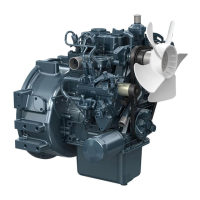1.
If
hose
clamps are loose
or
water leaks, tighten hose
clamp securely.
2. Replace hoses and tighten hose clamps securely,
if
radiator hoses are swollen, hardened
or
cracked.
Replace hoses and hose clamps every 2 years
or
earlier,
if
checked and found that hoses are swollen, hardened
or
cracked.
•Pre
caution
at
overheating
Take the following actions in the event the coolant
temperature be nearly
or
more than the boiling point, what
is called "Overheating". Take these actions
ifthe
engine's
alarm buzzer sounds
or
the alarm lamp lights up.
1. Stop
the
engine operation in a safe place and keep the
engine unloaded idling.
2. Do
not
stop the engine suddenly. Stop it after about 5
minutes
of
unloaded idling.
3.
If
the engine stalls within about 5 minutes
of
running
under
no
load, immediately leave and keep yourself
away from the machine. Never open the hood and any
other part.
4. Keep yourself and others well away from the engine
for further 10 minutes
or
while the steam blown out.
5. Checking that there gets no danger such
as
burn, get
rid
of
the causes
of
overheating according to the
manual, see "Troubleshooting" section. And then, start
again
the
engine.
•Anti-fr
eeze
A CAUTION
To
avoid
personal
injury
:
• When
using
anti-freeze,
put
on
some
protection
such
as rubber gloves.
•
If
shou
ld
drink
anti
-freeze,
throw
up
at
once
and
take medical attention.
• When anti-freeze comes
in
contact
with
the
skin
or
clothing,
wash
it
off
immediately.
•
Do
not
mix
different types
of
anti-freeze.
• Keep fire
and
children away
from
anti
-freeze.
•
Be
mindful
of
the
environment
and
ecology.
Before
draining
any
fluids,
find
out
the
correct
way
of
disposing
by
checking
with
local
codes.
•
Also,
observe
the
relevant environmental
protection
regulations when
disposing
of
oil,
fuel, coolant, brake fluid,
filter
s
and
batteries.
If
it
freezes, coolant can damage the cylinders and
radiator.
It
is necessary,
if
the ambient temperature falls
below o• C (32° F),
to
remove coolant after operating
or
to
add anti-freeze to it.
1. There are 2 types
of
anti-freeze available; use the
pe
rmanent type (PT)
for
this engine.
2. Before adding anti-freeze for the first time, clean the
radiator interior by pouring fresh water and draining
it
a few times.
PERIODIC SERVICE 17
3. The procedure for mixing
of
water and anti-freeze
differs according to the make
of
the anti-freeze and
the
ambient temperature. Refer to SAE J1034 standard,
more specifically also
to
SAE J814c.
4. Mix the anti-freeze with water, and then fill in
to
the
radiator.
IMPORT
ANT:
• When the anti-freeze is mixed with water, the anti-
freeze mixing ratio must
be
less than 50%.
Vol%
Freezing Point Boiling Point
*'
Anti-freeze
"C
OF
"C
OF
40 -24 -12
106 222
50 -37 -
34
108 226
*
At
1.013 x 1 O'
Pa
(760 mmHg) pressure
(atmospheric). A higher boiling point is obtained
by
using a radiator pressure cap which permits the
development
of
pressure within the cooling system.
NOTE:
• The above data represent industry standards
that
necessitate a minimum glycol content in
th
e
concentrated anti-freeze.
• When the coolant level drops due
to
evaporation,
add
water only
to
keep the anti-freeze mixing ratio
les
s
than 50%. In case
of
leakage. add anti-freeze
and
water in the specified mixing ratio before filling into
the
radiator.
• Anti-freeze absorbs moisture. Keep unused anti-
freeze in a tightly sealed container.
• Do not use radiator cleaning agents when anti-freeze
has been added to the coolant. (Anti-freeze contains
an anti-corrosive agent, which will react with
the
radiator cleaning agent forming sludge which will
affect the engine parts.)
•Radiator
cement
As the radiator is solidly constructed, there is little
possibility
of
water leakage. Should this happen, however,
radiator cement can easily fix it.
If
leakage is serious,
contact your local KUBOTA dealer.

